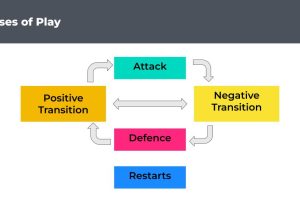Revolutionizing Soccer: Applying Data Analytics to Develop Game Models
Soccer is a game that requires a combination of physical fitness, technical skills, and tactical awareness. Coaches and players are always looking for ways to improve their performance and gain an edge over their opponents. Data analytics has emerged as a powerful tool that can help teams develop game models that are based on empirical evidence rather than intuition alone.
Understanding soccer and data analytics is the first step in developing effective game models. Soccer is a complex game with many variables that can impact the outcome of a match. Data analytics can help teams to identify key metrics that are most relevant to their style of play and develop strategies that maximize their strengths while minimizing their weaknesses.
Key metrics in soccer analytics include possession, passes completed, shots on target, and goals scored. These metrics can be used to evaluate individual player performance as well as the overall effectiveness of a team’s game model. By analyzing these metrics, coaches and players can identify areas for improvement and make data-driven decisions that lead to better outcomes on the field.
Key Takeaways
- Data analytics can help soccer teams develop game models based on empirical evidence.
- Key metrics in soccer analytics include possession, passes completed, shots on target, and goals scored.
- Analyzing these metrics can help coaches and players identify areas for improvement and make data-driven decisions.
Understanding Soccer and Data Analytics
Soccer, also known as football, is a sport that has been played for centuries and is enjoyed by millions of people worldwide. It is a game that requires a high level of skill, strategy, and teamwork. The objective of the game is to score more goals than the opposing team by placing the ball into the opposing team’s goal post.
Data analytics has become an increasingly important aspect of soccer in recent years. It involves collecting and analyzing data to gain insights into player and team performance. This data can be used to develop game models and strategies that can help teams win matches.
Soccer analytics involves the use of data analytics to analyze player and team performance. It encompasses a wide range of techniques, including statistical analysis, machine learning, and data visualization. By analyzing data from matches and training sessions, analysts can identify patterns and trends that can help teams improve their performance.
Data analytics can be applied to various aspects of soccer, including player recruitment, game strategy, and injury prevention. For example, data analytics can be used to identify players who have the potential to perform well in a particular position based on their physical attributes and performance data.
Furthermore, data analytics can be used to develop game models that take into account various factors such as the opposing team’s strengths and weaknesses, the playing surface, and weather conditions. These game models can help teams develop effective strategies that can give them an edge over their opponents.
In summary, data analytics is an essential tool for soccer teams looking to improve their performance. By analyzing data from matches and training sessions, teams can gain valuable insights that can help them develop effective game models and strategies. The use of data analytics in soccer is a testament to the importance of technology in the beautiful game.
Key Metrics in Soccer Analytics
Soccer analytics is all about using data to measure, quantify, and analyze player and team performance. By analyzing key metrics, coaches and analysts can gain valuable insights into how their team is performing, identify areas for improvement, and develop effective game models that maximize their team’s strengths while minimizing their weaknesses. In this section, we will explore some of the key metrics used in soccer analytics and how they can be used to develop effective game models.
Performance Indicators
Performance indicators are metrics that are used to measure the success of a player or team in a particular aspect of the game. Some common performance indicators in soccer include:
- Goals scored
- Shots on target
- Pass completion rate
- Tackles won
- Interceptions
- Distance covered
By tracking these performance indicators over time, coaches and analysts can identify patterns and trends in player and team performance, and develop strategies to improve performance in areas where they are underperforming.
Quantifying Success
One of the biggest challenges in soccer analytics is quantifying success. While goals scored is an obvious measure of success, it doesn’t tell the whole story. A team that scores a lot of goals may still be vulnerable defensively, or may struggle to maintain possession. That’s why it’s important to look at a range of metrics to get a more complete picture of a team’s performance.
One way to do this is to use Expected Goals (xG). xG is a statistical measure of the quality of a team’s scoring chances. By analyzing the quality and quantity of a team’s shots, analysts can calculate the team’s xG for a match or season. This can be a useful metric for identifying teams that are over- or under-performing relative to their xG.
Player and Team Analysis
Another key aspect of soccer analytics is player and team analysis. By analyzing individual player performance, coaches and analysts can identify areas where players need to improve, and develop strategies to maximize their strengths.
Some common metrics used in player analysis include:
- Pass completion rate
- Key passes
- Dribbles completed
- Shots on target
- Tackles won
- Interceptions
Team analysis, on the other hand, focuses on how the team as a whole is performing. This can include metrics like:
- Possession percentage
- Pass completion rate
- Shots on target
- Goals conceded
- Clean sheets
By analyzing these metrics, coaches and analysts can identify areas where the team is underperforming, and develop strategies to improve performance.
Development of Game Models in Soccer
Developing game models in soccer involves analyzing data to create a strategy that suits a team’s playing style and evaluates their tactical performance. This process allows coaches to identify strengths and weaknesses in their team, and develop a plan to maximize their potential.
Incorporating Playing Style
One important aspect of developing game models is incorporating a team’s playing style. This involves analyzing data on the team’s past performances to identify patterns in their gameplay. For example, if a team is known for their quick passing and counter-attacking style, the game model should reflect this by prioritizing fast transitions and quick attacking play.
To incorporate playing style into game models, coaches can use various data analytics tools, such as tracking data and video analysis. These tools can help coaches identify the key aspects of a team’s playing style and develop a strategy that maximizes their strengths.
Learn More about Soccer Game Models
Evaluating Tactical Performance
Another crucial aspect of developing game models is evaluating a team’s tactical performance. This involves analyzing data on the team’s performance in different areas of the game, such as possession, passing accuracy, and shots on goal.
By evaluating tactical performance, coaches can identify areas where their team is performing well and areas where they need to improve. For example, if a team is struggling to maintain possession, the game model should prioritize possession-based play and encourage players to maintain possession for longer periods.
To evaluate tactical performance, coaches can use various data analytics tools, such as performance metrics and statistical analysis. These tools can help coaches identify areas where their team needs to improve and develop a plan to address these issues.
Overall, developing game models in soccer is an important process that can help coaches maximize their team’s potential. By incorporating playing style and evaluating tactical performance, coaches can develop a strategy that suits their team’s strengths and weaknesses, and helps them achieve their goals.
The Impact of Advanced Analytics on Soccer
Advanced analytics has revolutionized the world of soccer by providing coaches and analysts with valuable insights into the game. These insights have helped teams to develop game models, improve player performance, and identify new talent. In this section, we will explore the impact of advanced analytics on soccer, focusing on its influence on coaching and player ranking and talent identification.
Influence on Coaching
Advanced analytics has transformed the way coaches approach the game. By analyzing data on player performance and team tactics, coaches are able to make more informed decisions about their game plan. For example, they can identify patterns in their opponents’ playing style and adjust their tactics accordingly. They can also analyze their own team’s performance to identify areas for improvement.
One of the most significant benefits of advanced analytics is that it allows coaches to make data-driven decisions. By analyzing data on player performance, coaches can identify which players are performing well and which ones need to improve. They can also identify which tactics are working and which ones are not. This allows coaches to make more informed decisions about substitutions, formations, and game plans.
Player Ranking and Talent Identification
Advanced analytics has also had a significant impact on player ranking and talent identification. By analyzing data on player performance, coaches and scouts can identify new talent and rank players based on their performance. This allows teams to make more informed decisions about which players to sign and which ones to let go.
One of the most significant benefits of advanced analytics in player ranking and talent identification is that it allows teams to identify players who may have been overlooked by traditional scouting methods. For example, a player’s performance in a lower league or in a different position may go unnoticed by scouts. However, by analyzing data on their performance, teams can identify these players and give them a chance to prove themselves at a higher level.
In conclusion, advanced analytics has had a significant impact on soccer by providing coaches and analysts with valuable insights into the game. It has transformed the way coaches approach the game and has had a significant impact on player ranking and talent identification. As technology continues to evolve, it is likely that advanced analytics will play an even greater role in the world of soccer in the future.
Case Studies of Data Analytics in Soccer
Moneyball in Soccer
Data analytics has become an increasingly important tool for soccer teams in recent years. One of the most famous examples of this is the use of data in soccer scouting, which has been dubbed “Moneyball in Soccer.” The term refers to the use of data analytics to identify undervalued players and build a team with a limited budget.
One of the most successful examples of Moneyball in Soccer is the case of Brentford FC, a team in the English Championship. Brentford used data analytics to identify undervalued players and build a team that was able to compete with much larger and more established teams. The team’s success has been attributed in large part to its use of data analytics, which has allowed it to identify players who might have been overlooked by other teams.
The Role of Wearable Sensors and Tracking Data
Wearable sensors and tracking data have also become increasingly important in soccer. These tools allow teams to collect data on players’ movements, heart rates, and other metrics in real time, which can be used to optimize training and improve performance on the field.
One of the most successful examples of the use of wearable sensors and tracking data in soccer is the case of FC Barcelona. The team has used wearable sensors to track players’ movements and collect data on their performance during training and games. This data has been used to optimize training programs and improve player performance on the field.
Other teams have also started to use wearable sensors and tracking data to improve performance. For example, the German national team used wearable sensors to track players’ movements and collect data on their performance during the 2014 World Cup. The data was used to optimize training programs and improve player performance on the field.
Overall, the use of data analytics in soccer has become increasingly important in recent years. Teams are using data to identify undervalued players, optimize training programs, and improve performance on the field. As the technology continues to improve, it is likely that data analytics will become even more important in the world of soccer.
Future Trends in Soccer Analytics
As technology continues to advance, so does the field of soccer analytics. The use of big data and computer graphics has allowed coaches and analysts to gain a deeper understanding of player performance and team strategy. In the future, these trends are expected to continue and evolve.
One future trend in soccer analytics is the use of visualizations to convey complex data in an easy-to-understand manner. By using computer graphics and other visual aids, coaches and analysts can quickly identify patterns and trends in player performance and team strategy. This can help them make more informed decisions about training and game-day tactics.
Another trend is the use of big data to analyze player performance at an unprecedented level of detail. By collecting and analyzing vast amounts of data on player movements, actions, and interactions, coaches and analysts can gain a deeper understanding of the game and develop more effective strategies. This trend is expected to continue as technology continues to advance and data collection becomes more sophisticated.
In addition to these trends, there is a growing focus on intensity in soccer analytics. By tracking metrics such as heart rate, distance covered, and sprint speed, coaches and analysts can gain a better understanding of player fitness and performance. This information can be used to optimize training programs and develop game-day strategies that take into account each player’s unique strengths and weaknesses.
Overall, the future of soccer analytics looks bright. As technology continues to evolve, coaches and analysts will have access to more data and tools than ever before. By leveraging these tools effectively, they can gain a deeper understanding of the game and develop more effective strategies that lead to success on the field.
Conclusion
Applying data analytics in developing game models in soccer is a promising approach to improving team performance. By analyzing large amounts of data generated by tracking systems, coaches and analysts can identify patterns in player movement, assess player performance, and develop strategies that maximize the team’s chances of winning.
One of the key benefits of data analytics in soccer is that it enables coaches and analysts to make evidence-based decisions. Rather than relying on intuition or guesswork, they can use data to identify areas for improvement and develop strategies that are tailored to the specific strengths and weaknesses of their team.
Another advantage of data analytics in soccer is that it enables teams to gain a competitive edge. By analyzing data on their opponents, teams can identify weaknesses in their game and develop strategies that exploit these weaknesses. This can be particularly effective in high-stakes games where even small advantages can make a big difference.
Of course, there are also challenges associated with applying data analytics in soccer. One of the biggest challenges is ensuring that the data is accurate and reliable. This requires sophisticated tracking systems that can capture data on player movement with a high degree of precision. It also requires skilled analysts who can interpret the data correctly and develop strategies that are based on sound statistical principles.
Despite these challenges, the use of data analytics in soccer is likely to become increasingly widespread in the coming years. As tracking systems become more sophisticated and the amount of data generated by games continues to grow, coaches and analysts will have access to more information than ever before. By using this data to develop game models that are tailored to the specific needs of their team, they will be able to improve performance and gain a competitive edge in even the toughest games.
Frequently Asked Questions
What are some examples of data analytics being applied in soccer game models?
Data analytics is being applied in soccer game models in various ways. For instance, it is used to analyze player performance, track player movements, and evaluate team strategies. Data analytics is also used to analyze goals, assists, shots on goal, and other key performance indicators to identify areas where improvements can be made.
How do soccer teams use data analytics to improve team performance?
Soccer teams use data analytics to improve team performance by analyzing player performance, tracking player movements, and evaluating team strategies. Data analytics can also be used to identify areas where improvements can be made, such as in team tactics, player training, and player recruitment.
What is the role of a soccer data analyst?
A soccer data analyst is responsible for analyzing data related to soccer games and players. This includes gathering data, performing statistical analysis, and creating reports that can be used to make decisions about team tactics, player recruitment, and other aspects of the game.
What are some key skills required for a career in data analytics in sports?
Some key skills required for a career in data analytics in sports include statistical analysis, data visualization, programming, and communication skills. It is also important to have knowledge of the sport you are analyzing and an understanding of the data sources available.
What are some challenges faced when applying data analytics in developing game models in soccer?
Some challenges faced when applying data analytics in developing game models in soccer include data quality, data availability, and data interpretation. It can also be challenging to integrate data analytics into traditional coaching methods and to get buy-in from coaches and players.
What are some potential benefits of using data analytics in soccer?
Using data analytics in soccer can provide teams with insights into player performance, team tactics, and opponent strategies. It can also help teams identify areas where improvements can be made, such as in player recruitment and training. Additionally, data analytics can help teams make more informed decisions about game strategies and tactics.







